University of East Anglia
The University of East Anglia (UEA) is a public research university in Norwich, England. Established in 1963 on a 320 acres (130 hectares) campus west of the city centre, the university has four faculties and 26 schools of study.[8] The annual income of the institution for 2016–17 was £273.7 million of which £35.6 million was from research grants and contracts, with an expenditure of £262.6 million.[1]
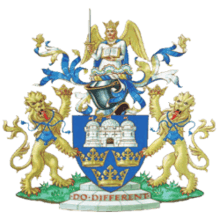 University of East Anglia coat of arms | |
| Motto | Do Different |
|---|---|
| Type | Public research university |
| Established | 1963 |
| Endowment | £7.7 million (as of 31 July 2017)[1] |
| Budget | £273.7 million (2016-17)[1] |
| Chancellor | Karen Jones CBE FRSA[2] |
| Vice-Chancellor | David Richardson[3] |
Administrative staff | 3,910[4] |
| Students | 17,925 (2018/19)[5] |
| Undergraduates | 13,215 (2018/19)[5] |
| Postgraduates | 4,710 (2018/19)[5] |
| Location | , , 52°37′18″N 1°14′30″E |
| Campus | 320 acres (130 ha)[6] |
| Chair of Council | Joe Greenwell CBE |
| Colours | Blue & yellow[7] |
| Affiliations | ACU AMBA Aurora Eastern ARC EUA Universities UK Norwich Research Park |
| Website | uea |
History
1960s
People in Norwich began to talk about the possibility of setting up a university in the nineteenth century,[9] and attempts to establish one in Norwich were made in 1919 and 1947. But due to a lack of government funding on both occasions the plans had to be postponed. The University of East Anglia was eventually given the green light in April 1960 for biological sciences and English studies students. Initially, teaching took place in the temporary "University Village", which was officially opened by chairman of the University Grants Committee, Keith Murray, on 29 September 1963.[10] Sited on the opposite side of the Earlham Road to the present campus, this was a collection of prefabricated structures designed for 1200 students, laid out by the local architectural firm Feilden and Mawson. There were no residences. The vice-chancellor and administration were based in nearby Earlham Hall.[11]
In 1961, the first vice-chancellor, Frank Thistlethwaite, had approached Denys Lasdun, an adherent of the "New Brutalist" trend in architecture, who was at that time building Fitzwilliam College, Cambridge, to produce designs for the permanent campus.[11] The site chosen was on the western edge of the city, on the south side of Earlham Road. The land, formerly part of the Earlham Hall estate was at that time occupied by a golf course.[12] Lasdun unveiled a model and an outline plan at a press conference in April 1963, but it took another year to produce detailed plans, which diverged considerably from the model. The first buildings did not open until late 1966.[11]
Lasdun put all the teaching and research functions into the "teaching wall", a single block 460 metres (1,510 feet) long following the contour of the site. Alongside this he built a walkway, giving access to the various entrances of the wall, with access roads beneath. Attached to the other, southern, side of the walkway he added the groups of terraced residences that became known as "Ziggurats". In 1968, Lasdun was replaced as architect by Bernard Feilden, who completed the teaching wall and library and created an arena-shaped square as a social space of a kind not envisioned in his predecessor's plans.[11] They would later become Grade II* listed status,[13] reflecting the importance of the architecture and the history of the campus.
In 1964 Arthur Miller's The Crucible became the first drama production to be staged at UEA with John Rhys Davies (later to appear in The Lord of the Rings trilogy), the drama society's first president.[14] In the same decade, in 1965, Benjamin Britten was appointed music adviser for UEA. In 1967 he conducted the UEA Choir in a performance of his War Requiem. In 1968 there were two royal visits from Princess Margaret and the Queen who each came to tour the new university for the first time.[14]
1970s

Malcolm Bradbury and Angus Wilson helped establish the first creative writing course in the UK. The School of Literature, Drama, and Creative Writing would later go on to produce successful authors including Sir Kazuo Ishiguro, Ian McEwan, Rose Tremain, John Boyne and Andrew Miller. In the same decade UEA:TV, under the name of Nexus, was formed and created student-made television. It operated for two hours a day over lunchtime. Concrete, the student newspaper was first officially launched in 1973, replacing Mandate which launched in 1965. Over the years students also enjoyed Phoenix, Can Opener, Mustard Magazine and Kett before Concrete re-launched in 1992.[14]
In 1972 the Centre for Climatic Research opened, founded by climatologist Hubert Lamb. Also notable in the same year, architect Bernard Feilden helped the university win a Civic Trust Award for the design of the Square, the university's main social space. A year later work began on the university lake, or Broad, as it is more commonly referred to. It involved excavating 18 acres (7.3 hectares) of gravel, which was arranged as part of a 'no money' deal where a local aggregate company took the gravel for free leaving with a landscaped body of water fed by the River Yare.[14]
In the 1970s the School of Computing Sciences first opened at UEA, and the university started offering education degrees from Keswick Hall, a manor house owned by the Gurney family and situated on the outskirts of Norwich. Initially this was only a postgraduate qualification, until the late 1970s when an undergraduate course was created. The gift of a collection of tribal art and 20th-century painting and sculpture, by artists such as Francis Bacon and Henry Moore, from Sir Robert Sainsbury and Lady Lisa Sainsbury resulted in the construction of the striking Sainsbury Centre for Visual Arts at the western end of the main teaching wall, one of the first major works of architect Norman Foster. The UEA's School of Fine Art opened in the same year of 1978.[14]
1980s

In 1984 the School of Law first moved to Earlham Hall. The building, dating back to 1580, was once home to many famous residents including Elizabeth Fry and the Gurney family.[15]
In 1986 the Climatic Research Unit (CRU) was opened within the Hubert Lamb Building. It had been named after Lamb who retired from the university in 1978. In 1988, as part of the University's 25th anniversary celebrations, Prince Charles visited the CRU building.
In 1989 the British Centre for Literary Translation was founded by WG Sebald, and The Arthur Miller Centre for American Studies was set up to encourage and facilitiate the study of the United States. Arthur Miller later in 2000 went on to spend his 85th birthday at UEA when he was made an honorary graduate. In the same year Kazuo Ishiguro won the Man Booker Prize and became one of three UEA graduates who would receive the award, along with Ian McEwan and Anne Enright.[14]
1990s
In 1990 the student radio station Livewire1350AM launched, completing the university's student media collective of print, television, and radio. It was opened by Radio 1 DJ John Peel and is now said to be one of the longest running student radio stations in the country.[16] In 1993 the Union of UEA Students took over the management of The Waterfront, a music venue and nightclub. It has hosted performers including Pulp, Radiohead, Arctic Monkeys, Marina and the Diamonds and Amy Winehouse.
In 1994 the Queen returned to UEA to open the Queen's Building, which hosts a number of classes within the School of Health Sciences. A year later in 1995 the Elizabeth Fry building was opened, providing new facilities for almost 800 students.
2000s
In 2000 UEA's reputation within the field of environmental research led to the government choosing the university as the site for the Tyndall Centre for Climate Change Research. The centre, named after the 19th-century UK scientist John Tyndall, brings together scientists, economists, engineers and social scientists from eight partner institutions.[17]
In 2001 the Sportspark, a multi-sports facility built thanks to a £14.5 million grant from the Sport England Lottery Fund, was formally opened by Princess Anne and brought international sporting facilities to Norwich. The Sportspark houses an Olympic-sized pool, floodlit astro-pitches, and the tallest climbing wall in Norfolk.[18]
In the same year UEA alumnus Sir Paul Nurse was awarded the Nobel Prize for Medicine. He won the prize jointly with Timothy Hunt and Leland Hartwell "for their discoveries of key regulators of the cell cycle".
In 2002 UEA's Medical School opened with 110 students enrolled. The school is a collaboration with the Norfolk and Norwich University Hospital and world-class research centres now part of the Norwich Research Park. In 2003 the School of Pharmacy opened, along with the Zuckerman Institute for Connective Environmental Research (ZICER). The walkways, the Teaching Wall, and Ziggurats also gained Grade II listed status following a government consultation.[19]
In 2004 the University of East Anglia was first represented on long-running TV quiz show University Challenge. The university's best performance on the show was in December 2012 when four high-profile alumni took part in a special series, coming second in the final against New College Oxford.
In 2005 the university, in partnership with the University of Essex and with the support of Suffolk County Council, the East of England Development Agency, Ipswich Borough Council, and the Learning and Skills Council, secured £15 million funding from the Higher Education Funding Council for England for the creation of a new campus in the Waterfront area of Ipswich, called University Campus Suffolk or UCS.[20] The campus opened in September 2007.[20] In May 2016 it became independent of the UEA and was renamed to the University of Suffolk.[21]
In 2006 the university opened Victory House, named after Lord Nelson's ship. The event took place on the anniversary of Lord Nelson's birth by his descendant Lord Walpole.
In 2008 INTO University Partnerships opened a £35m six-storey building named INTO University of East Anglia with 415 en-suite study-bedrooms and classroom space for 600 students. The institution, which works closely with UEA, focuses on the provision of foundation courses for international students, including English language, especially English for academic purposes. Shortly after opening, similar partnerships were created between INTO and Exeter and Newcastle.[22]
In November 2009, computer servers at the university's Climatic Research Unit were hacked and the stolen information made public. Over 1,000 emails, 2,000 documents, and source code were released. Because the Climate Research Unit is a major repository for data regarding man-made global warming, the release, which occurred directly prior to the 2009 United Nations Climate Change Conference, attracted international attention and led to calls for an inquiry.[23] As a result, no fewer than eight investigations were launched in both the UK and US, but none found evidence of fraud or scientific misconduct, and the academics were subsequently fully exonerated.[24]
2010–present
In 2010 the Thomas Paine Study Centre was opened by playwright Trevor Griffiths. Named after the local luminary and visionary thinker, the building became home to the Norwich Business School. In 2012 the university won its second Queen's Anniversary Prize for its distinguished creative writing programme, having won one previously for its School of International Development. The award helped bolster the region's reputation as a literary hub, and helped Norwich to achieve its status as England's first UNESCO City of Literature in 2012.[14]
In 2013 the university celebrated its 50th anniversary,[25] ranking Number 1 in the Times Higher Education Magazine Student Experience league table.[26] It was in this year UEA also launched its first free Massive open online course (MOOC) in partnership with Future Learn.[27] Topics covered by UEA's Moocs over the years have included branding, screenwriting, environmental justice and food fraud.
In 2014 UEA opened its most environmentally-friendly building yet, Crome Court, which has won a number of awards for sustainability.[28] Also in 2014 part of the campus was used for location filming as the Avengers new HQ during filming of the Avengers: Age of Ultron. The Sainsbury Centre for Visual Arts at UEA doubles as the home of the Avengers in Age of Ultron, Ant-Man, Captain America: Civil War and Spider-Man: Homecoming[29] Robert Downey Jr. was spotted on the grounds during filming in 2014 and a number of students were employed as extras.[30]
In 2015 'Britain's Greenest Building', The Enterprise Centre, opened on campus, helping the university win further awards for its environmental credentials.[31] Also in 2015 parts of campus played host to Radio 1's Big Weekend which was officially located at Earlham Park. International acts including Fall Out Boy, Muse, Foo Fighters and Taylor Swift performed. Swift used the grounds at Earlham Hall as her dressing room.[32]
In late September 2016 two new accommodation blocks opened. Barton House and Hickling House were named after two of the Norfolk Broads and have increased the number of rooms available to new students.[33] In this year the Vice-Chancellor David Richardson unveiled a '2030 vision' which includes a £300m investment in campus - refurbishing existing buildings as well as building new teaching and learning spaces.[34]
In January 2017 Queen Elizabeth II visited UEA campus to attend the latest exhibition at the Sainsbury Centre for Visual Arts. This was the Queen's third visit (she also visited in 1968 and 1994), and was the eighth visit by the Royal Family to the institution.[35][36]
Campus
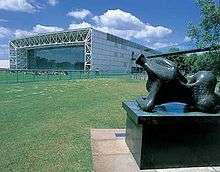
Features of the UEA campus include Earlham Hall, childhood home of Elizabeth Fry, which is now home to UEA Law School; the Sainsbury Centre for Visual Arts at the western end of the main teaching wall designed by Norman Foster to house the art collection of Sir Robert Sainsbury and Lady Lisa Sainsbury, it also features as the new avengers headquarters in Avengers: Age of Ultron, Ant Man and Marvel Cinematic Universe films; and Sportspark, a multi-sports facilities built in 2001 thanks to a £14.5 million grant from Sport England Lottery Fund.[18]
The campus is regularly evolving, and now stretches across the Norwich Research Park with the Edith Cavell Building and the Bob Champion Research and Education Building considered part of its campus over by the Norfolk and Norwich University Hospital.[37] Newest buildings on the campus include two new accommodation blocks, and the Enterprise Centre, said to be Britain's greenest building.[38]
Other features include the large university lake or "broad" at the southern edge of campus and "The Square", a central outdoor meeting place flanked by concrete steps.
Accommodation blocks on the university campus include Constable Terrace, Nelson Court, and Britten, Paston, Colman, Victory, Kett and Browne Houses. These residences are named after Horatio Nelson, John Constable, Benjamin Britten, Jeremiah Colman, Horatio Nelson's ship HMS Victory, Robert Kett, Sir Thomas Browne and the Paston family, the authors of the Paston Letters. The Ziggurat accommodation blocks are Grade II listed. The university also manages Mary Chapman Court, a hall of residence in Norwich city centre, and the University Village, a short walk away from campus.[39] UEA's accommodation block, Crome Court, opened in September 2014, containing the university's most eco-friendly flats.[40] Two new blocks; Hickling and Barton House (named after the broads) opened in September 2016.

Facilities on campus include the Union Pub and Bar, a 24-hour library, a concert and gig venue called the LCR (Lower Common Room), a canteen called the Campus Kitchen, a café/coffee shop called the Blend, a bar/coffee shop called Unio, a graduate bar called the Scholar's Bar and The Street with a 24-hour launderette, the Union shop, a coffee shop called Ziggy's, a branch of Barclays bank, and a Waterstones book shop. Most of these are situated in the centre of the campus, next to the Square. Other food establishments situated on campus include Café 57 and the Bio Cafe.[41] There is also a medical centre, dentist, and pharmacy, located on the eastern side of the campus.
The campus is linked to the city centre and railway station by frequent buses, operated by First Norfolk & Suffolk, via Unthank Road or Earlham Road. Other transport links include First buses to the Norfolk and Norwich University Hospital and to Bowthorpe, as well as Konectbus services to Watton, Dereham and Costessey via park and ride. National Express provides coach services to London, and Megabus operates low cost intercity travel to cities including Cambridge, Birmingham, Bristol and Cardiff.[42]
Academic profile
The postgraduate master of arts in creative writing, founded by Sir Malcolm Bradbury and Sir Angus Wilson in 1970, is regarded as the most respected in the United Kingdom, and admission to the programme is competitive.[43] The course has gone on to produce a number of distinguished authors, including Sir Kazuo Ishiguro, Ian McEwan, Anne Enright, Tash Aw, Andrew Miller, Owen Sheers, Tracy Chevalier, Trezza Azzopardi, Panos Karnezis and Suzannah Dunn. The German émigré novelist W. G. Sebald also taught in the School of Literature and Creative Writing, and founded the British Centre for Literary Translation, until his death in a car accident in 2001.[44] Experimental novelist Alan Burns was the university's first writer-in-residence.[45]
The Climatic Research Unit, founded in 1972 by Hubert Lamb in the School of Environmental Sciences,[46] has been an early centre of work for climate change research. The school was also stated to be "the strongest in the world" by the chief scientific adviser to the UK government, Sir David King, during a lecture at the John Innes Centre in 2005.[47]
Admissions
| 2016 | 2015 | 2014 | 2013 | 2012 | |
|---|---|---|---|---|---|
| Applications[48] | 24,050 | 23,740 | 20,755 | 18,535 | 21,400 |
| Offer Rate (%)[49] | 79.9 | 80.4 | 78.7 | 76.7 | 71.5 |
| Enrols[50] | 4,390 | 4,170 | 3,280 | 3,440 | 3,540 |
| Yield (%) | 22.8 | 21.8 | 20.1 | 24.2 | 23.1 |
| Applicant/Enrolled Ratio | 5.48 | 5.69 | 6.33 | 5.39 | 6.05 |
| Average Entry Tariff[51][lower-alpha 1] | 154 | 407 | 423 | 406 | 426 |
East Anglia had the joint 25th highest average entry qualification for undergraduates of any UK university in 2015, with new students averaging 407 UCAS points,[52] equivalent to just below ABBbc in A-level grades. According to the 2017 Times and Sunday Times Good University Guide, approximately 10.5% of East Anglia's undergraduates come from independent schools.[53] In 2014 the ratio of applications to acceptances was 5.9 to 1. In 2015/16 the proportion of students admitted to the university from independent schools was 10.5%.
Rankings
| National rankings | |
|---|---|
| Complete (2021)[54] | 21 |
| Guardian (2020)[55] | 30 |
| Times / Sunday Times (2020)[56] | 23 |
| Global rankings | |
| ARWU (2019)[57] | 201-300 |
| CWTS Leiden (2019)[58] | 112 |
| QS (2020)[59] | 269= |
| THE (2020)[60] | 190= |
| British Government assessment | |
| Teaching Excellence Framework[61] | Gold |
The results of the Research Excellence Framework (REF), published on 18 December 2014, showed that over 82% of the University's research activity was deemed to be "world leading" or "internationally excellent".[62] UEA was ranked 10th in the UK for the quality of its research outputs and 21st overall amongst all mainstream British institutions - a rise of 12 places since the last assessment in 2008.[63]
The university ranks in the world top 1% according to the Times Higher Education world rankings 2015/16[64] and within the world top 100 for research excellence in the Leiden Ranking 2016.[65]
In 2012 the university was named the 10th best university in the world under 50 years old, and third best within the United Kingdom.[66] In national league tables the university has most recently been ranked 18th in the UK by The Times and Sunday Times, and 14th by The Complete University Guide.[67][68][69]
In April 2013 the university was ranked number one for student experience according to Times Higher Education Magazine.[70] It currently ranks Top 3 for student satisfaction in the National Student Survey when ranking mainstream English universities. UEA is the only institution to rank top five since the survey began.[70]
Organisation
Faculties and schools
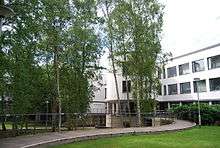
The university offers over 300 courses in its four faculties, which contain 26 schools of study:[4]

- Faculty of Arts and Humanities
- Art, Media and American Studies
- History
- Interdisciplinary Institute for the Humanities
- Literature, Drama and Creative Writing
- Politics, Philosophy and Language and Communication Studies
- Faculty of Medicine and Health Sciences
- Norwich Medical School
- Health Sciences
- Faculty of Science
- Actuarial Sciences
- Biological Sciences
- Biochemistry
- Chemistry
- Computing Sciences
- Engineering
- Environmental Sciences
- Geography
- Mathematics
- Natural Sciences
- Pharmacy
- Physics
- Faculty of Social Sciences
- Economics
- Education and Lifelong Learning
- International Development
- UEA Law School
- Norwich Business School
- Psychology
- Social Work
Student life

All students of the university and some INTO UEA students automatically become members of the union, but do have the right to opt out of membership. Membership confers the ability to take part in the union's activities such as clubs and societies, and being involved in the democratic processes of the union. The union is a democratic organisation run by its members via an elected student officer committee and student council. It is affiliated to the National Union of Students.
The UEA Student Union has over 200 sports clubs and societies ranging from men's and women's football clubs and cheerleading society to a Quidditch team.[71] The UEA Media Collective encompasses the student newspaper Concrete, UEA:TV (previously named Nexus UTV)[72] and the student radio station Livewire 1350AM. One of its more famous former presenters and managers is Greg James, the BBC Radio 1 presenter.[73]
The UEA Student Union brings together the student community through its events like Pimp My Barrow, which was an annual fundraising event for The Big C, and involves ingeniously decorated wheelbarrows from 2006 to 2019. It has raised more than £50,000 for the Norfolk charity.[74] The annual Derby Day sports event sees UEA take on the University of Essex in approximately 40 sports. UEA has won the Derby Day trophy all seven times since 2013.[75]
The UEA Student Union also organises gigs and club nights at the Nick Rayns LCR, or Lower[76] Common Room in Union House. The LCR is home to hundreds of music gigs every year. The students' union also runs the Waterfront venue, off campus in Norwich's King Street. Acts to have performed at these venues include Captain Beefheart, The Cure, Coldplay, Pere Ubu U2, Haim, The Smiths, Red Hot Chili Peppers, and Iron Maiden. The UEA Gig List is a rather complete listing of the artists who have performed at UEA since 1963 and is published as a book by the UEA Gig History Project and illustrated with posters, photographs and ticket stubs. The Project was awarded a Council for Advancement and Support of Education (CASE) award in 2018 for engagement with alumni.
The union also operates a number of other services within Union House. This includes the Union Pub and Bar, Scholar's Bar, and Unio. Its building underwent a refurbishment in 2015 after a £6 million investment from the university.[77]
Public events
The university's lecture theatres regularly host film screenings, discussions, lectures and presentations for the public to attend.[78]
UEA Literary Festival
The University hosted its inaugural literary festival in 1991 and has welcomed notable speakers including Madeleine Albright, Martin Amis, Martin Bell, Alan Bennett, Cherie Blair, Melvyn Bragg, Eleanor Catton, Richard Dawkins, Alain de Botton, Sebastian Faulks, Niall Ferguson, Stephen Fry, Frank Gardner, Richard E. Grant, Germaine Greer, Seamus Heaney, Clive James, P. D. James, Doris Lessing, Mario Vargas Llosa, Hilary Mantel, Iris Murdoch, Rageh Omaar, Michael Palin, Jeremy Paxman, Harold Pinter, Stephen Poliakoff, Terry Pratchett, Salman Rushdie, Simon Schama, Will Self, John Simpson, Zadie Smith, Paul Theroux, Peter Ustinov, Shirley Williams and Robert Winston.[79]
Notable alumni



UEA alumni in the sciences include the 2001 Nobel Prize in Physiology or Medicine laureate and former President of the Royal Society Sir Paul Nurse (PhD, 1973);[80] Robert Koch Prize, Lasker Award and Gairdner Foundation International Award winning co-discoverer of Hepatitis C and of the Hepatitis D genome Michael Houghton (Biological Sciences, 1972);[81][82] Darwin Medal, Darwin–Wallace Medal and Erwin Schrödinger Prize winning evolutionary biologist Nick Barton (PhD, 1979);[83] Potamkin Prize winning pathologist Karen Duff (Biological Sciences, 1987);[84] climate scientists Tim Lenton,[85] Chris Turney,[86] Neil Adger,[87] Benjamin D. Santer,[88] Keith Briffa,[89] Timothy Osborn,[90] and Peter Thorne;[91] vaccinologist Sarah Gilbert,[92] and the Fellows of the Royal Society James Barber,[93] virologist Nicola Stonehouse, Keith Beven,[94] Mervyn Bibb,[95] Lucy Carpenter, Richard Flavell,[96] Don Grierson,[97] Brian Hemmings,[98] Terence Rabbitts,[99] Nick Talbot.[100]
Literary alumni include the 2017 Nobel Prize in Literature laureate Sir Kazuo Ishiguro (Creative Writing, 1980),[101] renowned German writer W. G. Sebald (PhD, 1973),[102] Booker Prize winners, Ian McEwan (Creative Writing, 1971),[101] and Anne Enright (Creative Writing, 1988);[101] Costa Book Award (formerly Whitbread Award) winners Dame Rose Tremain (Creative Writing, 1967),[103] Andrew Miller (Creative Writing, 1991),[104] David Almond (English Literature, 1993),[105] Tash Aw (Creative Writing, 2003),[106] Emma Healey (Creative Writing, 2011),[107] Susan Fletcher (Creative Writing, 2002),[108] Adam Foulds (Creative Writing, 2001),[109] Avril Joy (History of Art, 1972) and Christie Watson (Creative Writing, 2009); and the Caine Prize winners Binyavanga Wainaina (MPhil, 2010), Helon Habila (PhD, 2008) and Henrietta Rose-Innes (PhD). Other alumni include Tracy Chevalier (Creative Writing, 1994),[110] John Boyne (Creative Writing, 1996),[111] Neel Mukherjee (Creative Writing, 2001), Mick Jackson (Creative Writing, 1992), Trezza Azzopardi (Creative Writing, 1998), Paul Murray (Creative Writing, 2001), James Scudamore (Creative Writing, 2006), Mohammed Hanif (Creative Writing, 2005), Richard House (PhD, 2008), Sebastian Barker (English Literature, 1970), Clive Sinclair (BA, 1969; PhD, 1983), Kathryn Hughes (Creative Writing, 1986), Peter J. Conradi, and Craig Warner (Creative Writing, 2014).
Alumni in international politics and government include the current King of Tonga Tupou VI (Development Studies, 1980) who also served as Prime Minister of Tonga from 2000 to 2006 and Foreign Minister from 1998 to 2004;[112] Governor General of Grenada Sir Carlyle Glean (Education, 1982);[113] Governor of Gibraltar Sir Robert Fulton (Social Sciences, 1970) who was formerly Commandant General Royal Marines;[114] Kiribati Vice President Teima Onorio (Education, 1990);[115] Turkish Deputy Prime Minister Murat Karayalçın (Development Economics, 1977) who also served as Foreign Minister;[116] Finance Ministers of Australia (Mathias Cormann), South Africa (Tito Mboweni), Rwanda (Donald Kaberuka, later President of the African Development Bank),[117][118][119] Thailand (Suchart Thada-Thamrongvech), and Venezuela (Pedro Rosas Bravo); Foreign Ministers of Iceland (Össur Skarphéðinsson) and The Gambia (Ousman Jammeh);[120][121] Defence Minister of The Maldives Adam Shareef; current Lieutenant Governor of Delhi Anil Baijal and Democratic Republic of the Congo Trade Minister Aimé Boji; and former Cabinet Ministers of Cyprus (Marios Demetriades), Peru (Gino Costa), South Sudan (Agnes Kwaje Lasuba), Kenya (Hassan Wario), Egypt (Gamal El-Araby), Tanzania (Juma Ngasongwa), Rwanda (Daphrose Gahakwa), Ethiopia (Sinknesh Ejigu and Junedin Sado), Seychelles (Rolph Payet and Peter Sinon), Turkey (Cüneyd Düzyol), Brunei (Suyoi bin Osman and Adanan Yusof) and Yemen (Yahya Al-Mutawakel).
Alumni in UK politics include the Labour Members of Parliament Rachael Maskell (Physiotherapy, 1994),[122] and Karin Smyth (Politics, 1988);[123] two former Leaders of the House of Lords, Valerie Amos, Baroness Amos (Applied Research in Education, 1978),[124] and Thomas Galbraith, 2nd Baron Strathclyde (Modern Languages & European Studies, 1982);[125] the Liberal Democrat peer Rosalind Scott, Baroness Scott of Needham Market (European Studies, 1999);[126] Brexit Party Member of the European Parliament Michael Heaver (Politics, 2011), and the Conservative Member of the Scottish Parliament Adam Tomkins (Law, 1990).[127] UEA is also the alma mater of the former Crossbench peer Tim Bentinck, 12th Earl of Portland (History of Art, 1975);[128] and the former Members of Parliament Caroline Flint (American Literature, History & Film, 1983),[129] Douglas Carswell (History, 1993),[130] Tony Colman (International Development), Jon Owen Jones (Ecology, 1975), Tess Kingham (Education), Judith Chaplin and Ivor Stanbrook (Law, 1995).[131][132][133][134][135]
In the arts alumni include the actors Matt Smith (Drama, 2005),[136] John Rhys-Davies,[137] Jack Davenport (English & American Literature, 1995),[138] James Frain (Drama, 1990),[139] and Roger Ashton-Griffiths (PhD, 2015);[140] comedians Paul Whitehouse,[141] Charlie Higson (English & American Literature),[111] Simon Day (Drama, 1989),[142] Arthur Smith (Comparative Literature, 1976),[143] and Nina Conti (Philosophy, 1995);[144] film director Gurinder Chadha (Development Economics, 1983);[137] art historians Philip Mould (History of Art, 1981),[145] Bendor Grosvenor (PhD, 2009),[146] and Paul Atterbury (Archaeology & Landscape History, 1972);[147] Chief Executive of the Royal Opera House Mary Allen (Creative Writing, 2003);[148] Chief Executive of English National Opera Séan Doran (Music 1983); BAFTA award-winning production designer Don Homfray (History, 1999),[149] and the Emmy Award winning choirmaster Gareth Malone (Drama, 1997).[150]
Alumni in the media include news correspondents Mark Stone (History of Art and Architecture, 2001), Stuart Ramsay,[151] Razia Iqbal (American Studies, 1985),[111] Geraint Vincent (History, 1994),[152] David Grossman (Politics, 1987),[111] and Selina Scott (English & American Literature, 1972); Radio 1 presenter Greg James (Drama, 2007);[152] political commentator Iain Dale (German & Linguistics, 1985);[153] Editor of the Evening Standard Emily Sheffield;[154] BBC executives Dame Jenny Abramsky (English),[155] Jonathan Powell (English Literature),[156] and James Boyle; and the weather forecasters Darren Bett (Environmental Sciences, 1989) and Penny Tranter (Environmental Sciences, 1982).[157][158]
UEA alumni in business and economics include the Argentine billionaire businessman and real estate developer Eduardo Costantini,[159] Hong Kong billionaire Billy Kan,[160] the founders of Autonomy (David Tabizel) and Café Rouge (Karen Jones), and CEOs of Computacenter, ICI, Jaguar Land Rover, Premier Foods, Diageo, and Punch Taverns. UEA is also the alma mater of the explorer Benedict Allen (Environmental Sciences, 1981);[161] England rugby player Andy Ripley;[162] and the football commentator Martin Tyler (Sociology, 1967).[163]
 King of Tonga Tupou VI (BA, 1980)
King of Tonga Tupou VI (BA, 1980)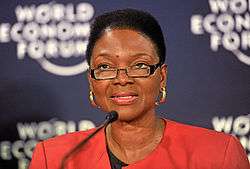 Former UN Emergency Relief Coordinator and Leader of the House of Lords Baroness Amos (Applied Research in Education, 1978)
Former UN Emergency Relief Coordinator and Leader of the House of Lords Baroness Amos (Applied Research in Education, 1978)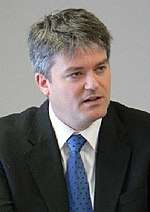 Australian Finance Minister Mathias Cormann (Law, 1994)
Australian Finance Minister Mathias Cormann (Law, 1994)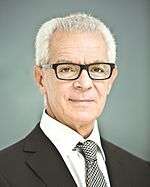 Argentine billionaire businessman Eduardo Costantini (MA, 1975)
Argentine billionaire businessman Eduardo Costantini (MA, 1975) 2007 Booker Prize winner Anne Enright (MA, 1988)
2007 Booker Prize winner Anne Enright (MA, 1988) Former Governor-General of Grenada Sir Carlyle Glean (MA, 1982)
Former Governor-General of Grenada Sir Carlyle Glean (MA, 1982) South African Finance Minister Tito Mboweni (MA, 1988)
South African Finance Minister Tito Mboweni (MA, 1988)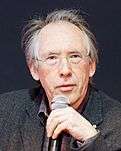 1998 Booker Prize winner Ian McEwan (MA, 1971)
1998 Booker Prize winner Ian McEwan (MA, 1971)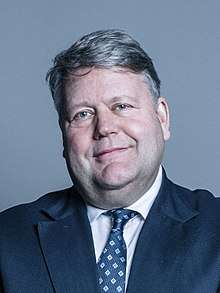 Former Leader of the House of Lords Lord Strathclyde (BA, 1982)
Former Leader of the House of Lords Lord Strathclyde (BA, 1982)
Notable academics
UEA has benefited from the services of academics at the top of their fields, including Sir Malcolm Bradbury and Sir Angus Wilson who co-founded the MA in Creative Writing programme;[164][165] Hubert Lamb who founded the Climatic Research Unit; Lord Zuckerman who was influential in the establishment of the School of Environmental Sciences;[166] Nobel Prize–winning chemist Richard Synge;[167] scientists Sir David King,[168] Sir David Baulcombe,[169] Jenni Barclay, Tom Wigley, Godfrey Hewitt, Michael Balls, Andrew Watson,[170] Christopher Lamb,[171] Alan Katritzky,[172] Jean Palutikof, Michael Gale,[173] Roy Markham,[174] Geoffrey Boulton,[175] Johnson Cann,[176] Hans Joachim Schellnhuber,[177] John Alwyne Kitching,[178] Thomas Bennet-Clark,[179] Jeremy Greenwood,[180] Tracy Palmer and Sophien Kamoun; mathematician Peter Chadwick; writers Angela Carter and Sarah Churchwell;[181] poet George Szirtes; poet laureate Sir Andrew Motion[182][182] historians Sir Richard Evans,[183] Paul Kennedy,[184] Patricia Hollis[185] and Michael Balfour; art historians Peter Lasko and Eric Fernie; historian Stephen Church; philosophers Martin Hollis[186] and Andreas Dorschel;[187] psychologist Dame Shirley Pearce; musician Sir Philip Ledger;[188] political scientists Lord Williams of Baglan and Sir Steve Smith; former Greek Finance Minister Yanis Varoufakis, and the High Court Judges Sir Clive Lewis[189] and Dame Beverley Lang.[190]
Present faculty include former IPCC Chairman Sir Robert Watson;[191] scientists Sir David Hopwood,[192] Phil Jones,[193] Corinne Le Quéré, Jonathan D. G. Jones,[194] Enrico Coen,[195] Frederick Vine[196] and Peter Liss;[197] sociologist Sir Tom Shakespeare, 3rd baronet;[198] writers Ian Rankin,[199] Giles Foden,[200] Amit Chaudhuri, and Christopher Bigsby; as well as the former Home Secretary Charles Clarke[201] and LBC Radio presenter Iain Dale[202]
Administration
Chancellors
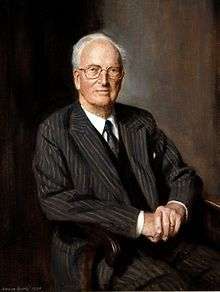
- Harold Mackintosh, 1st Viscount Mackintosh of Halifax (1962–1964)
- Oliver Franks, Baron Franks (1965–1984)
- Owen Chadwick (1984–1994)
- Sir Geoffrey Allen (1994–2003)
- Sir Brandon Gough (2003–2012)
- Dame Rose Tremain (2013–2016)
- Karen Jones (2016–present)
Vice-Chancellors
- Frank Thistlethwaite (1961–1980)
- Sir Michael Thompson (1980–1986)
- Derek Burke (1987–1995)
- Dame Elizabeth Esteve-Coll (1995–1997)
- Vincent Watts (1997–2002)
- Sir David Eastwood (2002–2006)
- Bill MacMillan (2006–2009)
- Edward Acton (2009–2014)
- David Richardson (2014–present)
See also
- List of Universities in the United Kingdom
References
- New UCAS Tariff system from 2016
- "Financial Statements for the Year to 31 July 2017" (PDF). University of East Anglia. p. 18. Retrieved 13 December 2017.
- "Chancellor - UEA". 18 August 2016.
- "Professor David Richardson, Vice Chancellor". University of East Anglia. Retrieved 3 September 2014.
- "Faculties and Schools". Retrieved 19 December 2014.
- "Where do HE students study?". Higher Education Statistics Agency. Retrieved 1 March 2020.
- "About uS". University of East Anglia. Retrieved 19 December 2014.
- The History of the University of East Anglia, Norwich. Continuum International Publishing Group. 2002. ISBN 9781852853365. Retrieved 29 October 2008.
- Lytton, Charlotte (17 April 2013). "The University of East Anglia guide". The Daily Telegraph. London.
- "History". University of East Anglia. Archived from the original on 5 February 2007. Retrieved 29 September 2019.
- Michael Sanderson (2002). The History of the University of East Anglia, Norwich. A&C Black. p. 81.
- Muthesius, Stefan (2000). The Postwar University: Utopianist Campus and College. New Haven and London: Yale University Press. pp. 139–149. ISBN 0-300-08717-9.
- Wilson, Bill; Nikolaus, Pevsner (2007). Norfolk 1: Norwich and North- East. Buildings of England (second ed.). Yale University Press. p. 347. ISBN 0-300-09607-0.
- Historic England. "Details from listed building database (1390647)". National Heritage List for England. Retrieved 2 November 2014.
- "UEA - 50 Years - Landmarks". Retrieved 18 August 2016.
- "Plans lodged to breathe new life into Norwich's historic Earlham Hall". Retrieved 18 August 2016.
- "Livewire1350 - LinkedIn". Retrieved 18 August 2016.
- "Tyndall Centre - About". Retrieved 1 July 2015.
- "Sportspark" (PDF). Archived from the original (PDF) on 19 December 2008. Retrieved 8 August 2008.
- "BBC News -'Dramatic' UEA buildings may be listed". Retrieved 1 July 2015.
- "HEFCE back University Campus Suffolk bid". Archived from the original on 7 February 2009. Retrieved 5 May 2008.
- "BBC News -University Campus Suffolk gains independence". Retrieved 15 July 2016.
- "INTO University of East Anglia". Archived from the original on 10 August 2016. Retrieved 15 July 2016.
- "Climategate: Scientists, Politicians War Over Hacked E-Mails". ABC News. Retrieved 15 October 2014.
- The eight major investigations covered by secondary sources include: House of Commons Science and Technology Committee (UK); Independent Climate Change Review (UK); International Science Assessment Panel (UK); Pennsylvania State University first panel and second panel (US); United States Environmental Protection Agency (US); Department of Commerce (US); National Science Foundation (US)
- "UEA 50 Years". Retrieved 13 May 2013.
- "University of East Anglia earns top ranking in UK-wide Student Experience Survey". Retrieved 13 August 2016.
- "UEA to offer first FutureLearn MOOC". Retrieved 13 August 2016.
- "Crome Court". Retrieved 13 August 2016.
- "UEA building has starring role in Marvel's Ant-Man". Retrieved 15 August 2016.
- "Enterprise Centre celebrated as world class sustainable building". Retrieved 15 August 2016.
- "Facebook: Radio 1's Big Weekend 2015". Retrieved 18 August 2016.
- "En Suite Hickling/Barton House". Retrieved 18 August 2016.
- "EDP: 15-year vision for UEA includes £300m campus investment". Retrieved 18 August 2016.
- "The Queen and The Duke of Edinburgh to visit the Sainsbury Centre at UEA". Retrieved 16 February 2017.
- "7 Times The Royal Family Visited UEA". Retrieved 16 February 2017.
- "UEA Campus Map". Retrieved 19 August 2015.
- "The Enterprise Centre". Retrieved 19 August 2015.
- "Mary Chapman Court". Archived from the original on 17 August 2013. Retrieved 10 August 2008.
- "En Suite Campus Crome Court". Retrieved 16 July 2015.
- "Cafes and Restaurants". Retrieved 16 July 2015.
- "Portal - Travel and Transport - UEA". Retrieved 22 August 2016.
- http://www.uea.ac.uk/creativewriting%7Cwork=University of East Anglia
- http://www.uea.ac.uk/lit/eventsnews/events/SebaldConference%7Cwork=University of East Anglia
- Ian McEwan (1995). "Class Work".
- http://www.cru.uea.ac.uk/about-cru/history%7Cwork=%5B%5DClimatic Research Unit
- "of East Anglia". Retrieved 15 October 2014.
- "End of Cycle 2016 Data Resources DR4_001_03 Applications by provider". UCAS. UCAS. 2016. Retrieved 10 February 2017.
- "Sex, area background and ethnic group: E14 University of East Anglia (UEA)". UCAS. UCAS. 2016. Retrieved 10 February 2017.
- "End of Cycle 2016 Data Resources DR4_001_02 Main scheme acceptances by provider". UCAS. UCAS. 2016. Retrieved 10 February 2017.
- "Top UK University League Table and Rankings". Complete University Guide.
- "University League Table 2018". Complete University Guide. Retrieved 25 April 2017.
- "The Times and Sunday Times Good University Guide 2017". The Good University Guide. London. Retrieved 16 August 2016.(subscription required)
- "University League Table 2021". The Complete University Guide. 1 June 2020.
- "University league tables 2020". The Guardian. 7 June 2019.
- "The Times and Sunday Times University Good University Guide 2020". Times Newspapers.
- "Academic Ranking of World Universities 2019". Shanghai Ranking Consultancy.
- "CWTS Leiden Ranking 2019 - PP top 10%". CWTS Leiden Ranking 2019.
- "QS World University Rankings 2020". Quacquarelli Symonds Ltd.
- "World University Rankings 2020". Times Higher Education.
- "Teaching Excellence Framework outcomes". Higher Education Funding Council for England.
- "Research Excellence Framework". UEA. Retrieved 19 December 2014.
- "Research Excellence Framework". Retrieved 16 July 2015.
- "New rankings place UEA in world top 150". UEA. Retrieved 19 August 2016.
- "League Table & Uni Guide". UEA. Retrieved 19 August 2016.
- Morgan, John (31 May 2012). "THE 100 Under 50 university rankings: results | General". Times Higher Education. Retrieved 17 August 2013.
- "The Times and Sunday Times University Good University Guide 2017". Times Newspapers. Retrieved 23 September 2016.
- "University league tables 2016". The Guardian. 25 May 2015. Retrieved 25 May 2015.
- "University League Table 2017". The Complete University Guide. Retrieved 25 April 2016.
- "UEA ranked third best university for student satisfaction". UEA. Retrieved 19 August 2016.
- UEA Student Union - Societies. Archived from the original on 5 August 2015. Retrieved 16 July 2015.
- "UEA TV". Archived from the original on 19 December 2014. Retrieved 19 December 2014.
- Greg James - Radio 1 (Part 2) - University of East Anglia (UEA). YouTube. 19 April 2012. Retrieved 16 July 2015.
- Pimp my Barrow: More than 2,000 students dress up and decorate wheelbarrows for long-running UEA fundraiser. Retrieved 16 July 2015.
- Breaking: UEA has won Derby Day. TheTab. Archived from the original on 27 January 2019. Retrieved 16 August 2018.
- "UEA Ticket Bookings". Archived from the original on 19 December 2014. Retrieved 19 December 2014.
- UEA invest £6 million for the refurbishment of Union House!. 3 December 2013. Retrieved 19 August 2016.
- "Events - UEA". Retrieved 18 August 2016.
- "UEA Literary Festival Archive". Retrieved 18 August 2016.
- "Sir Paul Nurse - Biographical". Nobelprize.org. Retrieved 23 November 2013.
- Liver Cirrhosis and Its Development - Google Books. books.google.co.uk. Retrieved 12 January 2014.
- Thompson, Gilbert (2014). Pioneers of Medicine Without a Nobel Prize. p. 209.
- ‘BARTON, Prof. Nicholas Hamilton’, Who's Who 2014, A & C Black, an imprint of Bloomsbury Publishing plc, 2014
- "Karen Duff, Ph.D". Columbia University. Retrieved 13 September 2014.
- "Professor Tim Lenton Chair in Climate Change/Earth Systems Science". University of Exeter. Retrieved 22 July 2012.
- University of East Anglia Alumni Directory
- "Professor Neil Adger". University of Exeter. Retrieved 3 March 2016.
- "Dr. Ben Santer". Moving By Degrees. American Public Media. Archived from the original on 26 June 2010.
- "Tree-climate relationships and dendroclimatological reconstruction in British Isles". British Library EThOS. Retrieved 5 March 2016.
- "Professor Timothy Osborn". University of East Anglia. Retrieved 30 September 2014.
- "Peter Thorne". North Carolina State University. Retrieved 30 September 2014.
- "Professor Sarah Gilbert". Nuffield Department of Medicine. Retrieved 22 April 2020.
- ‘BARBER, Prof. James’, Who's Who 2014, A & C Black, an imprint of Bloomsbury Publishing plc, 2014
- "Honorary degrees awarded at the University of Bristol – Wednesday, 22 July". University of Bristol. Retrieved 4 March 2016.
- ‘BIBB, Prof. Mervyn James’, Who's Who 2016, A & C Black, an imprint of Bloomsbury Publishing plc, 2016
- ‘FLAVELL, Dr Richard Bailey’, Who's Who 2014, A & C Black, an imprint of Bloomsbury Publishing plc, 2014
- ‘GRIERSON, Prof. Donald’, Who's Who 2014, A & C Black, an imprint of Bloomsbury Publishing plc, 2014
- ‘HEMMINGS, Dr Brian Arthur’, Who's Who 2014, A & C Black, an imprint of Bloomsbury Publishing plc, 2014
- RABBITTS, Prof. Terence Howard, Who's Who 2014, A & C Black, an imprint of Bloomsbury Publishing plc, 2014
- "Professor Nick Talbot FRS FSB". University of Exeter. Retrieved 23 September 2014.
- Barnett, Laura (16 November 2011). "Is the UEA creative writing course still the best? | Education". The Guardian. Retrieved 23 November 2013.
- "James R. Martin, 'On Misunderstanding W.G. Sebald', Cambridge Literary Review , IV/ 7 (Michaelmas, 2013), pp. 123–38" (PDF). Archived from the original (PDF) on 11 March 2016. Retrieved 4 March 2016.
- "BBC News - Novelist Rose Tremain appointed as new UEA chancellor". Bbc.co.uk. 14 April 2013. Retrieved 23 November 2013.
- Interview by Dan Eltringham (18 June 2011). "Small talk: Andrew Miller". FT.com. Retrieved 23 November 2013.
- "David Almond". David Almond. Archived from the original on 23 July 2012. Retrieved 23 November 2013.
- British Council (15 November 2013). "Tash Aw | British Council Literature". Literature.britishcouncil.org. Retrieved 23 November 2013.
- "Best-selling author praised for depiction of dementia". The Guardian. Retrieved 5 January 2015.
- Custom byline text: Alastair Mabbott (22 March 2010). "Author Susan Fletcher on new novel Corrag". Herald Scotland. Archived from the original on 3 December 2013. Retrieved 23 November 2013.
- "Adam Foulds | The Man Booker Prizes". Themanbookerprize.com. Archived from the original on 2 December 2013. Retrieved 23 November 2013.
- "Tracy Chevalier - About Me". Tchevalier.com. 11 December 2012. Archived from the original on 5 October 2013. Retrieved 23 November 2013.
- "eZiggurat January 2013 - University of East Anglia". Netcommunity.uea.ac.uk. Retrieved 23 November 2013.
- "One in seven countries has leader who studied in UK". BBC News. Retrieved 26 September 2014.
- "Biography: Carlyle Arnold Glean". GOV.gd. 7 May 2013. Retrieved 23 November 2013.
- ‘FULTON, Lt-Gen. Sir Robert (Henry Gervase)’, Who's Who 2014, A & C Black, an imprint of Bloomsbury Publishing plc, 2014
- "Pacific Women in Politics". Pacific Women in Politics. Retrieved 15 October 2014.
- "TÜRKÝYE BÜYÜK MÝLLET MECLÝSÝ". Retrieved 15 October 2014.
- http://www.mathiascormann.com.au/speeches/15-08-2007_FirstSpeech.pdf
- "Human Resource: Human Resource Detail_Eng". Mp.parliament.go.th. Archived from the original on 17 October 2015. Retrieved 23 November 2013.
- "Leader Profile: Donald Kaberuka, President of the AfDB". Devex. Retrieved 4 February 2014.
- http://www.europarl.europa.eu/meetdocs/2009_2014/documents/afet/dv/201/201105/20110524_cv_skarphedinsson_en.pdf
- "Minister of Energy". Statehouse.gm. 13 August 1953. Retrieved 23 November 2013.
- "Physio heads for Westminster as victorious MP". Chartered Society of Physiotherapy. Retrieved 8 May 2015.
- "Karin Smyth - Candidate for Bristol South". Labour Party. Retrieved 8 May 2015.
- ‘AMOS’, Who's Who 2014, A & C Black, an imprint of Bloomsbury Publishing plc, 2014
- ‘STRATHCLYDE’, Who's Who 2014, A & C Black, an imprint of Bloomsbury Publishing plc, 2014
- ‘SCOTT OF NEEDHAM MARKET’, Who's Who 2014, A & C Black, an imprint of Bloomsbury Publishing plc, 2014
- "No camp: What happens to UK credit rating if it's Yes?". Carluke Gazette. 18 September 2014. Retrieved 6 May 2016.
- "BBC Radio 4 - The Archers - David Archer". Bbc.co.uk. Retrieved 23 November 2013.
- ‘FLINT, Rt Hon. Caroline Louise’, Who's Who 2014, A & C Black, an imprint of Bloomsbury Publishing plc, 2014
- "UKIP gains first elected MP with Clacton by-election win". BBC News. Retrieved 10 October 2014.
- "Associate Fellows - University of East Anglia". UEA. 7 July 2011. Archived from the original on 3 December 2013. Retrieved 23 November 2013.
- "Jon Owen Jones: Electoral history and profile | Politics". The Guardian. Retrieved 23 November 2013.
- "Tess Kingham: Electoral history and profile | Politics". The Guardian. Retrieved 23 November 2013.
- Michael Mcnair-Wilson (22 February 1993). "Obituary: Judith Chaplin - People - News". London: The Independent. Retrieved 23 November 2013.
- Andrew Roth. "Obituary: Ivor Stanbrook | Politics". The Guardian. Retrieved 23 November 2013.
- "Norfolk - People - UEA graduate takes control of the TARDIS". BBC. 3 January 2009. Retrieved 23 November 2013.
- "V". "Video: Lord of the Rings star among successful former University of East Anglia students who will receive honorary degrees - Education - Eastern Daily Press". Edp24.co.uk. Retrieved 23 November 2013.
- "Jack Davenport - About This Person - Movies & TV". NYTimes.com. 1 March 1973. Retrieved 23 November 2013.
- "biography". Aboutjamesfrain.com. 14 March 1968. Retrieved 23 November 2013.
- "Roger Ashton-Griffiths". Andrew Nurnberg Associates. Archived from the original on 7 March 2016. Retrieved 16 February 2016.
- "TELEVISION / The Paul Whitehouse experience: He was the blond one with the big teeth who did a 'lodda work for cheriddy' - Smashie to Harry Enfield's Nicey. What was his name again? It's a question that won't be asked if Paul Whitehouse's new show is as big a hit as James Rampton predicts - Arts & Entertainment". London: The Independent. 20 September 1994. Retrieved 23 November 2013.
- "Simon Day - Awards Hosts | Presenters | Stand Up Comedians | NMP Live Booking Agent". Nmplive.co.uk. Archived from the original on 2 December 2013. Retrieved 23 November 2013.
- UEA. "Arthurian legend returns to his creative roots". Retrieved 15 October 2014.
- "Monkey business with lots to shout about - Features - East Anglian Daily Times". Eadt.co.uk. Retrieved 23 November 2013.
- ‘MOULD, Philip Jonathan Clifford’, Who's Who 2014, A & C Black, an imprint of Bloomsbury Publishing plc, 2014; online edn, Oxford University Press, Dec 2013
- "- Philip Mould & Company". Archived from the original on 24 September 2014. Retrieved 15 October 2014.
- ‘ATTERBURY, Paul Rowley’, Who's Who 2014, A & C Black, an imprint of Bloomsbury Publishing plc, 2014; online edn, Oxford University Press, Dec 2013
- ‘ALLEN, Mary Fitzgerald’, Who's Who 2014, A & C Black, an imprint of Bloomsbury Publishing plc, 2014
- "Don Homfray obituary". The Guardian. Retrieved 22 February 2016.
- "About Gareth". Gareth Malone. Archived from the original on 12 September 2010. Retrieved 23 November 2013.
- "STUART RAMSAY". University of East Anglia. Retrieved 16 July 2018.
- https://www.uea.ac.uk/admissions/brochures/gen.ug.brochure.pdf
- "Interview with Iain Dale Part 1". Political Promise (blog). 14 April 2011. Archived from the original on 24 April 2011. Retrieved 14 April 2011.
- "Emily Sheffield, sister-in-law of former PM David Cameron, named Evening Standard editor". inews.co.uk. 12 June 2020. Archived from the original on 13 June 2020. Retrieved 25 June 2020.
- "Observer Profile: Jenny Abramsky | Comment | The Observer". Observer.theguardian.com. Retrieved 23 November 2013.
- "Professor. Jonathan Powell - Research - Royal Holloway, University of London". Pure.rhul.ac.uk. Retrieved 23 November 2013.
- "Weather - Darren Bett". Bbc.co.uk. 10 September 2012. Retrieved 23 November 2013.
- "Archived copy" (PDF). Archived from the original (PDF) on 6 May 2013. Retrieved 21 November 2013.CS1 maint: archived copy as title (link)
- "Eduardo Costantini — making a fortune during economic chaos". Financial Times. Retrieved 25 August 2016.
- "Billy Kan". Forbes. Retrieved 13 August 2017.
- "Benedict Allen Explorer Author Filmmaker Public Speakers". Benedictallen.com. Retrieved 23 November 2013.
- "Andy Ripley". London: Telegraph. 17 June 2010. Retrieved 23 November 2013.
- Interview by Rob Harris. "How to be ... Martin Tyler | Media". The Guardian. Retrieved 23 November 2013.
- ‘BRADBURY, Sir Malcolm (Stanley)’, Who Was Who, A & C Black, an imprint of Bloomsbury Publishing plc, 1920–2014
- ‘WILSON, Sir Angus (Frank Johnstone)’, Who Was Who, A & C Black, an imprint of Bloomsbury Publishing plc, 1920–2014
- Chalfont, Alun (2 April 1993). "Obituary: Lord Zuckerman". The Independent. London.
- Elsden, S. R. (24 August 1994). "Obituary: Richard Synge". The Independent. London.
- ‘KING, Sir David (Anthony)’, Who's Who 2014, A & C Black, an imprint of Bloomsbury Publishing plc, 2014
- ‘BAULCOMBE, Prof. Sir David (Charles)’, Who's Who 2014, A & C Black, an imprint of Bloomsbury Publishing plc, 2014
- ‘WATSON, Prof. Andrew James’, Who's Who 2014, A & C Black, an imprint of Bloomsbury Publishing plc, 2014
- ‘LAMB, Prof. Christopher John’, Who Was Who, A & C Black, an imprint of Bloomsbury Publishing plc, 1920–2014
- ‘KATRITZKY, Prof. Alan Roy’, Who's Who 2014, A & C Black, an imprint of Bloomsbury Publishing plc, 2014
- ‘GALE, Michael Denis’, Who Was Who, A & C Black, an imprint of Bloomsbury Publishing plc, 1920–2014
- ‘MARKHAM, Roy’, Who Was Who, A & C Black, an imprint of Bloomsbury Publishing plc, 1920–2014
- ‘BOULTON, Prof. Geoffrey Stewart’, Who's Who 2014, A & C Black, an imprint of Bloomsbury Publishing plc, 2014
- ‘CANN, Prof. Johnson Robin’, Who's Who 2014, A & C Black, an imprint of Bloomsbury Publishing plc, 2014
- ‘SCHELLNHUBER, Prof. Hans Joachim, (John)’, Who's Who 2014, A & C Black, an imprint of Bloomsbury Publishing plc, 2014
- ‘KITCHING, John Alwyne’, Who Was Who, A & C Black, an imprint of Bloomsbury Publishing plc, 1920–2014
- ‘BENNET-CLARK, Thomas Archibald’, Who Was Who, A & C Black, an imprint of Bloomsbury Publishing plc, 1920–2014
- ‘GREENWOOD, Dr Jeremy John Denis’, Who's Who 2014, A & C Black, an imprint of Bloomsbury Publishing plc, 2014
- "Angela Carter - British Council Literature". Retrieved 15 October 2014.
- ‘MOTION, Sir Andrew’, Who's Who 2014, A & C Black, an imprint of Bloomsbury Publishing plc, 2014
- "Archived copy". Archived from the original on 16 December 2013. Retrieved 16 December 2013.CS1 maint: archived copy as title (link)
- John Crace. "Interview: Paul Kennedy - Education - The Guardian". the Guardian. Retrieved 15 October 2014.
- ‘HOLLIS OF HEIGHAM’, Who's Who 2014, A & C Black, an imprint of Bloomsbury Publishing plc, 2014
- ‘HOLLIS, Prof. (James) Martin’, Who Was Who, A & C Black, an imprint of Bloomsbury Publishing plc, 1920–2007
- ‘DORSCHEL, Prof. Andreas’, Kürschners Deutscher Gelehrten-Kalender 2014. Bio-bibliographisches Verzeichnis deutschsprachiger Wissenschaftler der Gegenwart, ed. Axel Schniederjürgen, 26th edition, vol. 1 (A–G), De Gruyter, Berlin – Boston, Mass. 2014, p. 663.
- ‘LEDGER, Sir Philip (Stevens)’, Who Was Who, A & C Black, an imprint of Bloomsbury Publishing plc, 1920–2007
- ‘LEWIS, Hon. Sir Clive (Buckland)’, Who's Who 2014, A & C Black, an imprint of Bloomsbury Publishing plc, 2014
- ‘LANG, Dame Beverley Ann Macnaughton’, Who's Who 2014, A & C Black, an imprint of Bloomsbury Publishing plc, 2014
- ‘WATSON, Sir Robert (Tony)’, Who's Who 2014, A & C Black, an imprint of Bloomsbury Publishing plc, 2014
- ‘HOPWOOD, Sir David (Alan)’, Who's Who 2014, A & C Black, an imprint of Bloomsbury Publishing plc, 2014
- ‘JONES, Prof. Philip Douglas’, Who's Who 2014, A & C Black, an imprint of Bloomsbury Publishing plc, 2014
- ‘JONES, Jonathan Dallas George’, Who's Who 2014, A & C Black, an imprint of Bloomsbury Publishing plc, 2014
- ‘COEN, Prof. Enrico Sandro’, Who's Who 2014, A & C Black, an imprint of Bloomsbury Publishing plc, 2014
- ‘VINE, Prof. Frederick John’, Who's Who 2014, A & C Black, an imprint of Bloomsbury Publishing plc, 2014
- ‘LISS, Prof. Peter Simon’, Who's Who 2014, A & C Black, an imprint of Bloomsbury Publishing plc, 2014
- ‘SHAKESPEARE, Sir Thomas William’, Who's Who 2014, A & C Black, an imprint of Bloomsbury Publishing plc, 2014
- "Ian Rankin to be UEA visiting professor". Retrieved 15 February 2017.
- "Professor Giles Foden - UEA". Retrieved 15 October 2014.
- ‘CLARKE, Rt Hon. Charles (Rodway)’, Who's Who 2014, A & C Black, an imprint of Bloomsbury Publishing plc, 2014
- "Iain Dale, Conservative blogger and journalist, and Visiting Professor, UEA". Retrieved 15 February 2017.
Further reading
- Dormer, P. and Muthesius, S. (2002) Concrete and Open Skies: Architecture at the University of East Anglia, 1962-2000. Unicorn Press.
- Sanderson, M. (2002) The History of the University of East Anglia, Norwich. Hambledon Continuum.
External links
| Wikimedia Commons has media related to University of East Anglia. |
